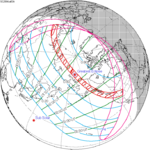Solar eclipse of May 20, 2012

Visibility
The annular phase will be visible from the Chinese coast, northern Taiwan, the south of Japan, and the western part of the United States. Guangzhou, Taipei, Tokyo and Albuquerque will be on the central path. Its maximum will occur in the North Pacific, south of the Aleutian islands for 5 min and 46.3 s, and finish in the western United States.

Animation of eclipse path North America
It will be the first central eclipse of the 21st century in the continental USA, and also the first annular eclipse there since the solar eclipse of May 10, 1994 which was also the previous eclipse of this series Solar Saros 128.

Animation of eclipse as viewed from Albuquerque, New Mexico, showing sunset before the eclipse ends
Related eclipses Solar eclipses 2011-2014
This set of solar eclipses repeat approximately every 177 days and 4 hours at alternating nodes of the moon's orbit.
Note: Partial solar eclipses on January 4, 2011 and July 1, 2011 occur in the previous lunar year eclipse set.
Solar eclipse series sets from 2011–2014
Saros 128
It is a part of Saros cycle 128, repeating every 18 years, 11 days, containing 73 events. The series started with partial solar eclipse on August 29, 984 AD. It contains total eclipses from May 16, 1417 through June 18, 1471 and hybrid eclipses from June 28, 1489 through July 31, 1543. Then it progresses into annular eclipses from August 11, 1561 through July 25, 2120. The series ends at member 73 as a partial eclipse on November 1, 2282. The longest duration of totality was 1 minutes, 45 seconds on June 7, 1453.
Series members 52-62 occur between 1901 and 2100:
| 52 | 53 | 54 |
|---|---|---|
 March 17, 1904 |  March 28, 1922 |  April 7, 1940 |
| 55 | 56 | 57 |
 April 19, 1958 |  April 29, 1976 |  May 10, 1994 |
| 58 | 59 | 60 |
 May 20, 2012 |  June 1, 2030 |  June 11, 2048 |
| 61 | 62 | |
 June 22, 2066 |  July 3, 2084 |
Source







